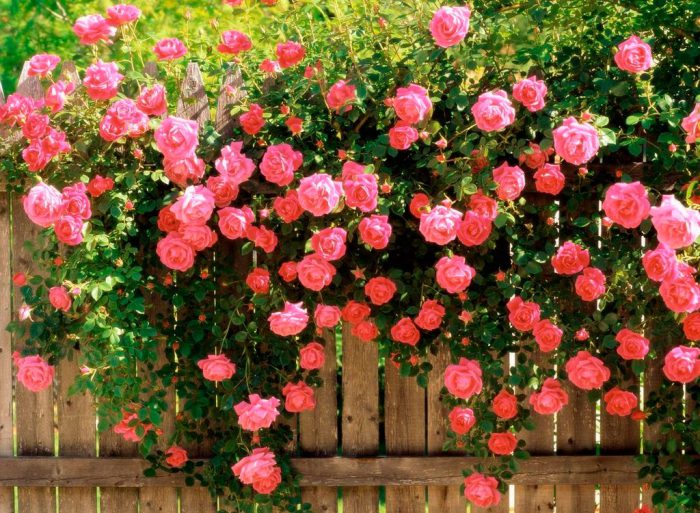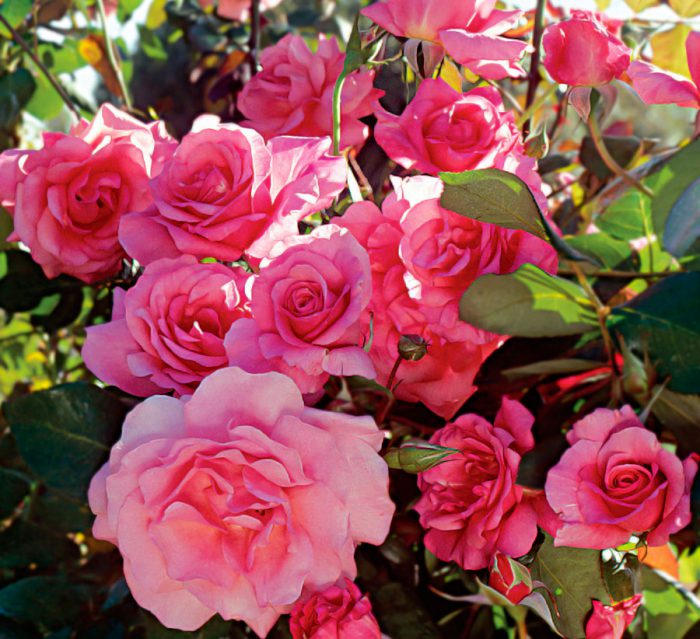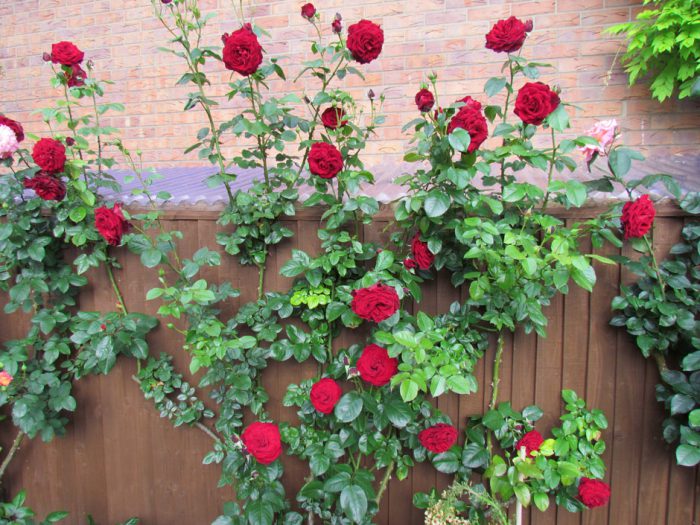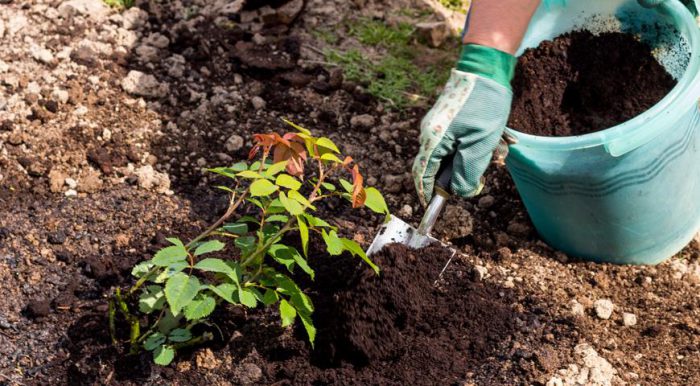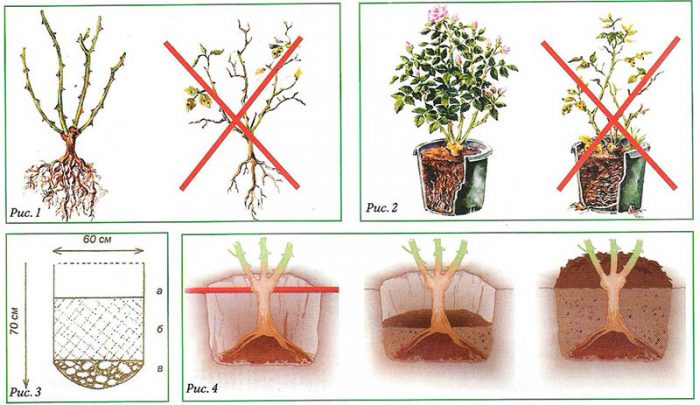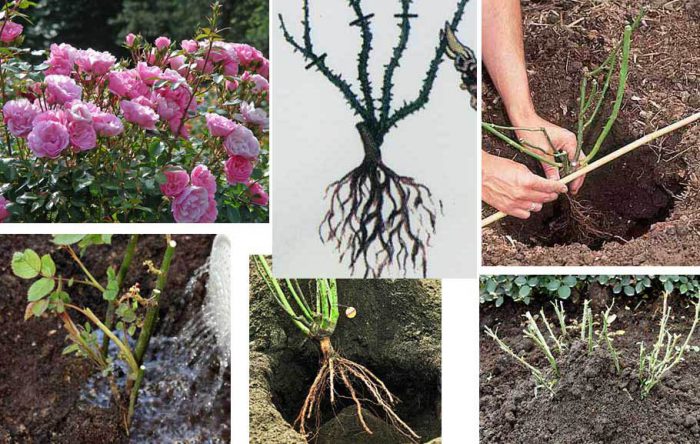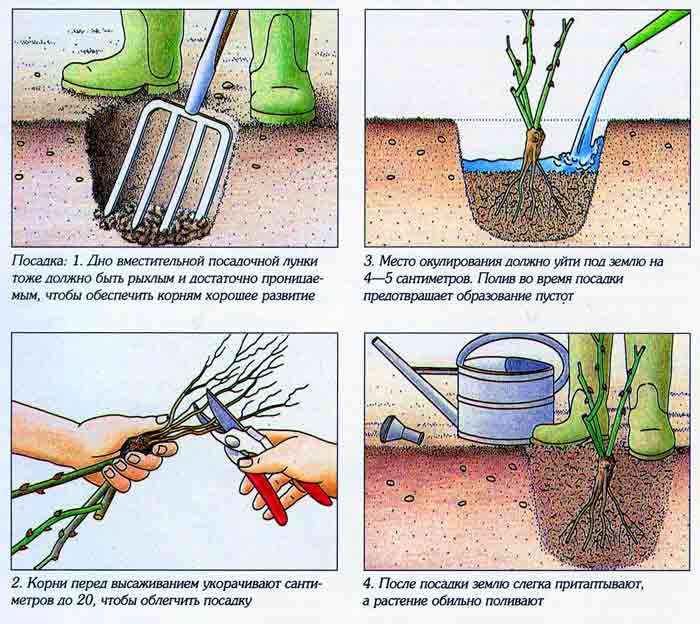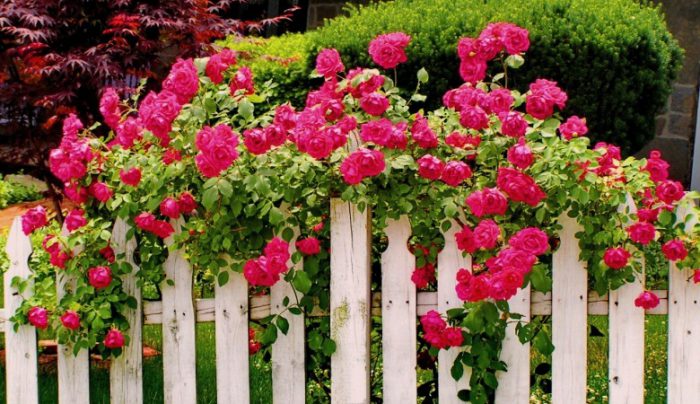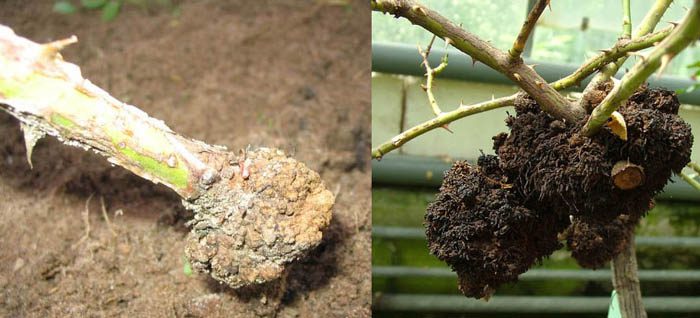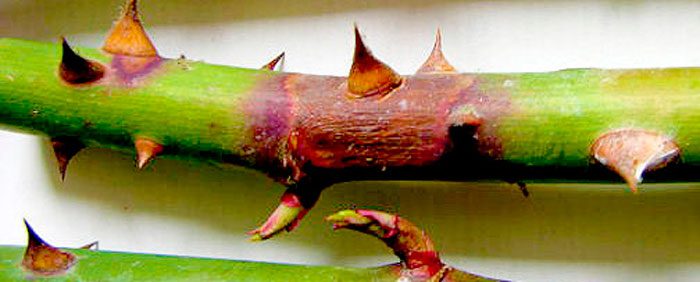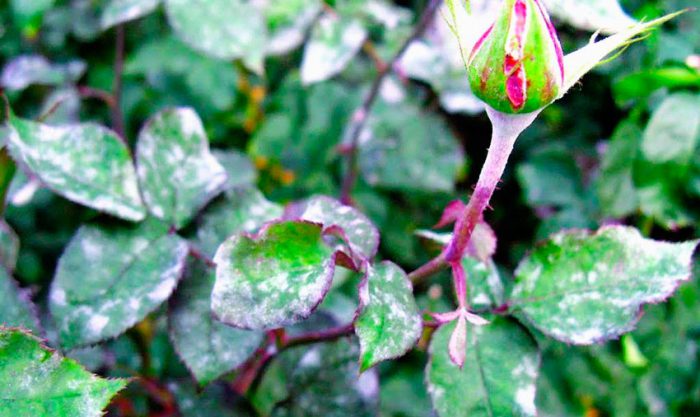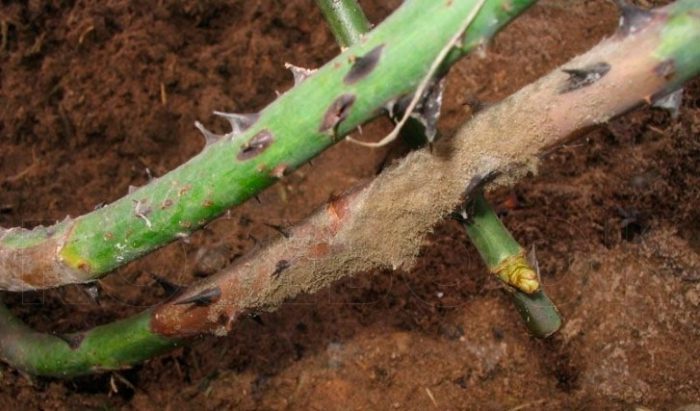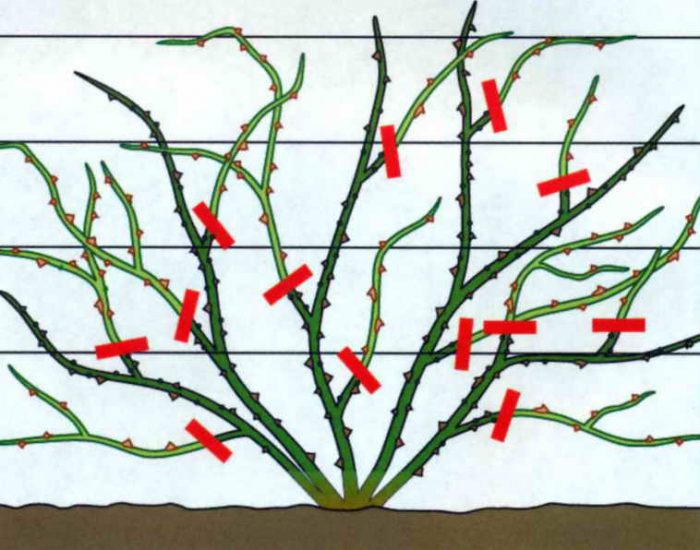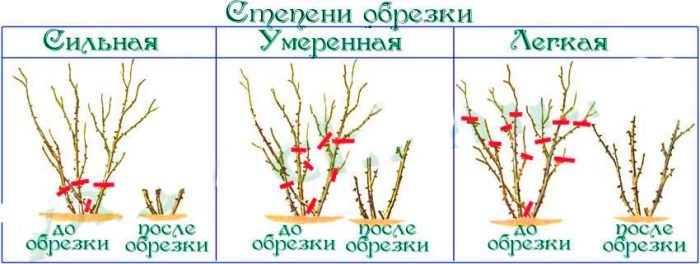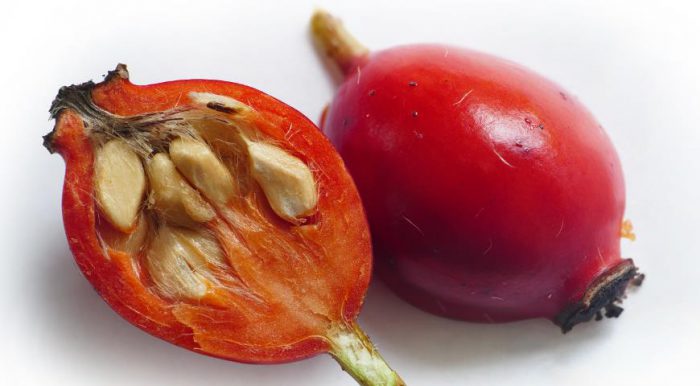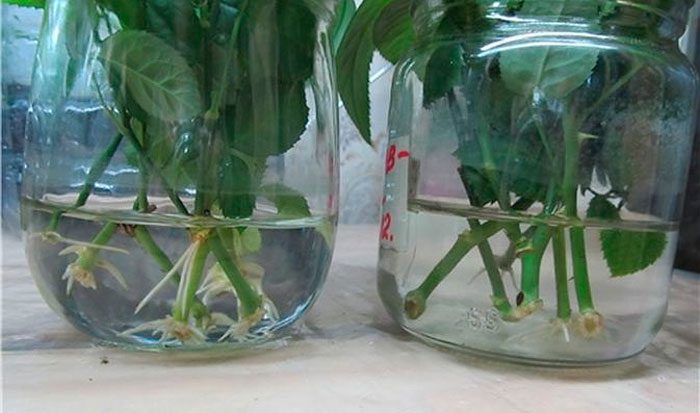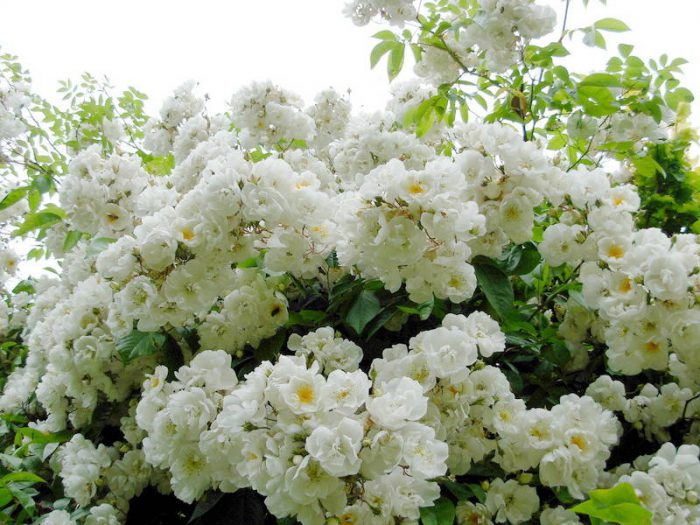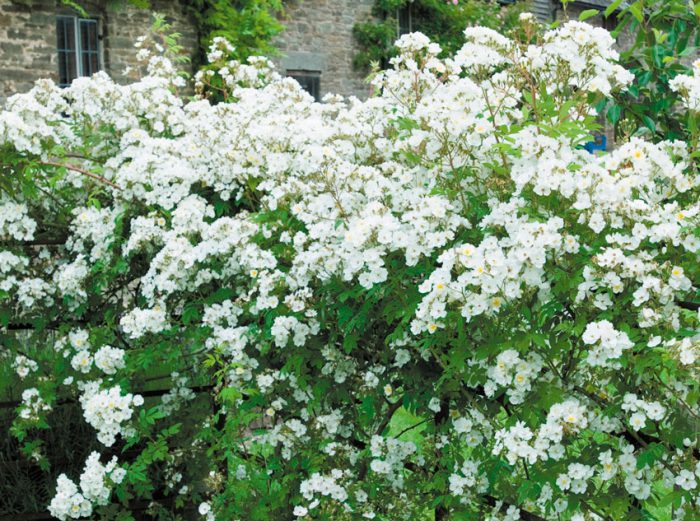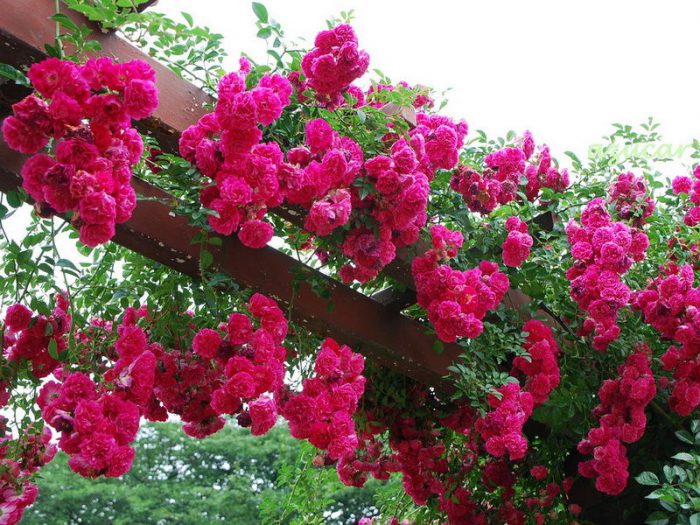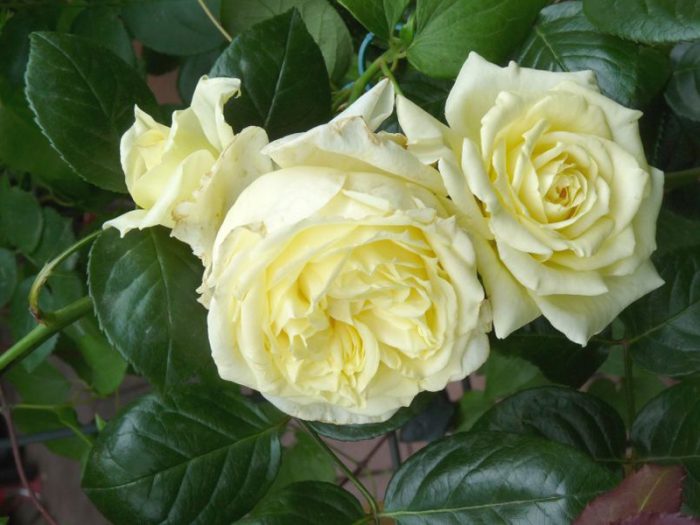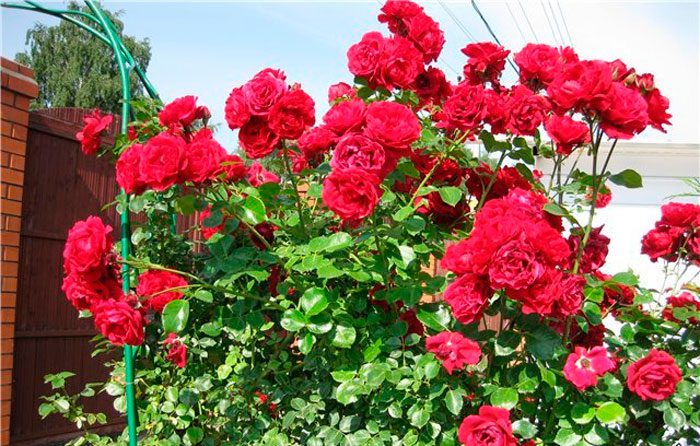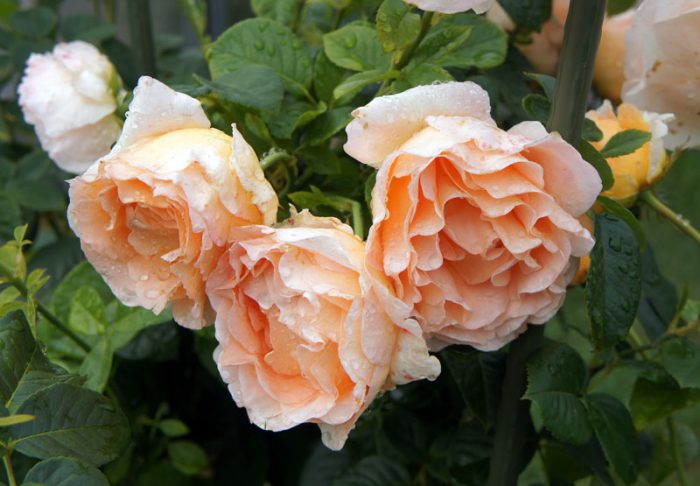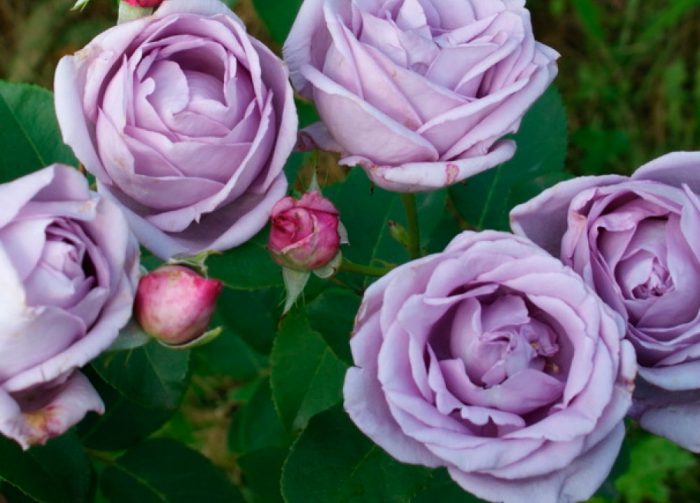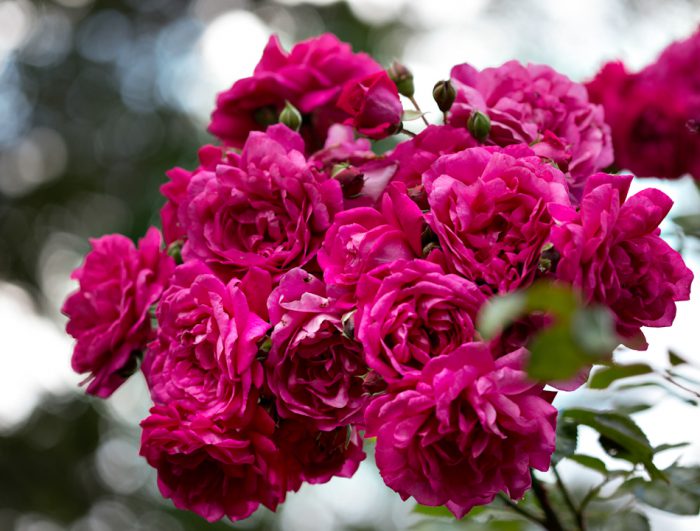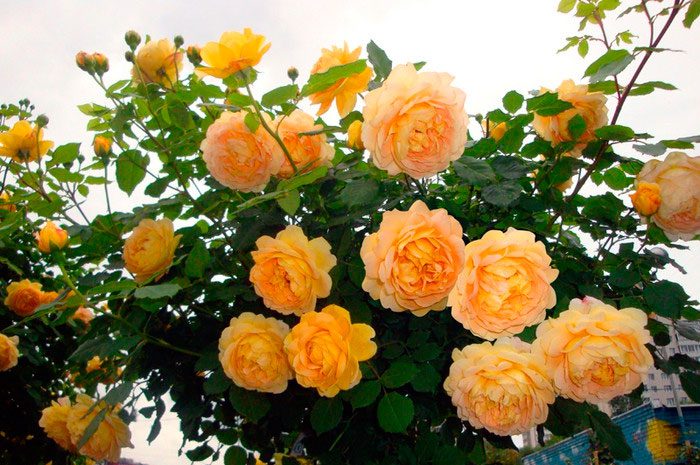Climbing roses include types of rose hips, as well as several varieties of garden roses, branching with rather long stems. They are directly related to the genus Rosehip. And these plants are very popular in vertical gardening of various structures, buildings and walls, and arbors. Such flowers can decorate both a large structure and a very small one. These plants are widely used to create various structures in the garden, namely, columns, gazebos, pyramids, garlands, as well as arches. And they are also remarkably combined with other plants, in this regard, their popularity is no less than that of a room or bush rose.
Content
Features of climbing roses
There is no general description for this type of plant, because they have many different forms and varieties. However, there is a classification of climbing roses, which has been adopted in international floriculture practice.
First group
Such plants are called climbing roses or rambler roses (Rambler). These flowers have long flexible shoots that are arched or creeping. They are painted in a deep green color, and spikes are located on their surface. In length, they can reach more than 500 centimeters. Glossy leathery leaves are small. Flowers can be double, semi-double and simple, their diameter, as a rule, does not exceed 25 millimeters. They have a rather weak aroma. The flowers are part of the inflorescences, which are located along the entire length of the stems. The flowering of such plants is quite abundant, and it lasts a little longer than 4 weeks. Flowering is observed in the first half of the summer period. A very large number of varieties have frost resistance and such plants are able to overwinter normally even under a relatively light shelter.This plant was born thanks to such species as: multi-flowered rose (multiflora) and Vihura rose.
Second group
Climbing (Climber) or large-flowered climbing roses (clammers) were bred by breeders when crossing groups of rambler roses with hybrid tea, tea, remontant roses, as well as floribunda rose. The length of the stems of such climbing roses can reach 400 cm. The flowers are quite large (diameter is more than 4 centimeters), and they are part of small loose inflorescences. Abundant flowering. A large number of varieties bloom 2 times during the season. The flowers have a shape similar to hybrid tea roses. These flowers are relatively frost-resistant and resistant to powdery mildew.
Third group
Climbing was formed by large-flowered mutating shrub roses, namely: grandiflora, hybrid tea, and floribunda. The difference between such plants and producing species is that they have even more vigorous growth and very large flowers (diameter from 4 to 11 centimeters), while they can be either single or part of not very large inflorescences. They also differ in fruiting, which occurs at a later date. Most of the varieties are characterized by repeated flowering. These plants are cultivated only in the southern regions of the temperate zone, where the winter period is relatively warm and mild.
Planting climbing roses in open ground


Watch this video on YouTube
Optimal time and place for landing
Absolutely all types of such plants are very capricious in nature. The same applies to climbing roses. To plant and care for such a plant, you need to adhere to certain rules. And you should also take into account the advice of experienced florists on the cultivation of a climbing rose. The choice of a site for planting must be approached with all responsibility. Such plants simply need a plot that will be illuminated by the sun from morning until lunchtime. In this case, the dew on the plant can dry out, which will help to avoid the appearance of fungal diseases. At lunchtime, when the sun's rays are most scorching, this area should be shaded, otherwise burns may appear on the surface of the foliage and petals. Also, a suitable site should be protected from northeast and north winds because it is quite cold. It is not recommended to decorate the corner of buildings with climbing roses. The fact is that the draft present there can destroy the delicate plant. For planting such flowers, experts advise choosing a site on the south side of the building. In order to plant climbing roses, you need a strip of soil only half a meter wide, but you should take into account that any structure, building or plant should be located at a distance of about 50-100 centimeters from such a flower.
Suitable soil must be water permeable. If, at the site chosen for planting, groundwater is located very close to the surface, these plants are planted on a special previously prepared elevation. In some cases, the roots of this type of roses can sink into the ground up to 200 centimeters. In order to prevent stagnation of liquid in the root system, the selected area should be located at least at a not very large slope. Loam is considered ideal for planting a climbing rose. If the soil is sandy, then it must be corrected before planting by adding clay when digging, and sand must be added to the clay soil. Such plants need soil saturated with nutrients, so the introduction of humus or humus is mandatory. You should also add bone meal to the soil, which is considered an excellent source of phosphorus. Prepare the soil well in advance.Ideally, this should be done 6 months before planting, but preparation can also be done 4 weeks before planting the rose.
In temperate climates, climbing roses are recommended to be planted in late September to mid-October. Planting can also be done in the spring. It can be held from the second half of April to the last days of May.
Autumn planting
If you are going to plant a climbing rose, you must first learn how to choose the highest quality planting material. Nowadays, you can buy seedlings of roses that are self-rooted, as well as those that are grafted onto rose hips. But how are they different? Grafted seedlings have one important difference from self-rooted ones. The fact is that the root system of such a seedling belongs to the wild rose, and on it there is a scion belonging to a varietal climbing rose. In this regard, planting and caring for a self-rooted rose should be somewhat different than for a grafted one. So, for example, a grafted seedling must be buried in the soil during planting so that the place where the graft is located is underground at a depth of 10 centimeters. With this method of planting, the part of the plant that was grafted begins to form its own root system, while the roots of the rose hip eventually become unnecessary and die off. In the case when, during planting, the scion was not buried in the ground, but remained above its surface, it can lead to the death of the plant. The fact is that the dog rose is a deciduous plant, and the grafted rose belongs to evergreens. If the planting was carried out in violation of the rules, then such a discrepancy between the rootstock and the scion can lead to the death of the cultivated part of the plant.
Saplings with an open root system must be immersed in a container of water for 1 day, and this should be done immediately before planting in open ground. After that, you should cut off all the leaves and cut off, using a pruner, those stems that are unripe or have been damaged. You should also trim the root system and the aboveground part, leaving 30 centimeters each. Cutting points should be treated with crushed charcoal. If you use grafted seedlings for planting, then they must carefully remove all the buds that are located below the scion. The fact is that rosehip shoots will begin to grow from them. Next, the planting material should be disinfected. To do this, it must be dipped in a solution of copper sulfate (3%).
The hole for planting a rose should be 50x50 in size. At the same time, a distance of at least 100 centimeters must be maintained between the planting pits. The top layer of soil most saturated with nutrients must be removed from the dug hole and connected to ½ part of the manure bucket. Part of the resulting soil mixture must be poured into the hole, and then a relatively large amount of water must be poured into it. This procedure must be carried out a day or two before the expected planting of the plant. On the day when you are going to plant a seedling, you need to prepare a special solution in order to process the root system before planting. To prepare the solution, dissolve 1 tablet of heteroauxin, 3 tablets of phosphorobacterin in 500 ml of water. Then pour this liquid into 9.5 liters of clay talker. Before the seedling is lowered into the hole, its roots should be dipped in the prepared mixture. A mixture of soil and manure should be poured into the hole with a mound. Then you need to place a seedling in the hole, while carefully straightening its roots. Fill the hole with the same mixture of soil and manure and compact the soil well. Do not forget that the place where the graft is located must be buried 10 centimeters into the ground. At the same time, for a self-rooted seedling, the root collar must be buried 5 or more centimeters into the ground. The planted plant must be well watered. After the liquid is absorbed into the soil, it will be necessary to add a mixture of soil with manure to the hole. Then the plant spuds to a height of 20 centimeters or more.
Spring planting
Roses planted in autumn overtake those that were planted in open ground in spring. At the same time, the latter need special increased attention to themselves. Before planting seedlings, they should trim the root system to 30 centimeters, while the stems must be shortened to 15–20 centimeters. When the plant is planted, it needs to be well watered and hilled high. Then it should be covered with a transparent film on top, while creating something similar to a mini-greenhouse. In these greenhouse conditions, the rose will take root relatively faster. Do not forget to air the seedling every day, for this you need to raise the shelter for a few minutes. Experts advise airing longer and longer each time, so the rose will also harden. After the threat of night frost is left behind, it will be possible to remove the shelter completely, and pour a layer of mulch on the soil surface in the hole. If the sapling was planted at a time when warm and dry weather was established, then the surface of the holes will need to be sprinkled with a layer of mulch (peat or other).
Outdoor climbing care for climbing roses


Watch this video on YouTube
How to properly care
In order for the climbing rose to grow and develop normally, it is necessary to learn how to properly water, feed, cut the plant. You also need to monitor the health of the rose and destroy pests in time. It is very important to learn how to properly prepare the bushes for wintering. This type of rose needs a reliable support. These plants can easily tolerate drought and therefore should not be watered abundantly. As a rule, they are watered 1 time in 7 days or in a decade, 10–20 liters of water should be poured onto 1 bush. Remember to water more often, but less. To keep water in the hole, it is recommended to build a not very low shaft of soil around it. When 2-3 days have passed since watering, it will be necessary to loosen the soil surface of the near-trunk circle to a depth of 5 to 6 centimeters. This will help to retain moisture in the soil and will also improve air access to the root system. In order to reduce the number of irrigations and practically exclude loosening of the soil, you need to cover its surface with a layer of mulch.
Young plants do not need to fertilize the soil until the end of the summer period, since there is a large amount of nutrients in the soil from the moment of planting. At the end of summer, the plant should be fed with a solution of potash fertilizers, this will help the rose prepare for the winter period. It is recommended in this case to use an infusion prepared on wood ash as a top dressing. In the second year of life, such plants need to be supplemented with mineral and organic fertilizers, while they should be alternated. And roses of the third and subsequent years of life should be fed only with organic fertilizers. So, for this, a solution consisting of 10 liters of water, 1 liter of manure and 1 tbsp. wood ash. If you wish, you can take another organic fertilizer instead of manure. During the period of intensive growth, climbing roses must be fed 5 times, while taking into account that during the flowering period, fertilizers cannot be applied to the soil.
Support for climbing roses


Watch this video on YouTube
For this type of rose, there is a huge variety of supports. So, as a support, you can use an old dried tree, a wooden, metal or polymer arch or lattice, as well as arc-shaped rods made of metal. But the best support for such a plant is a building or any structure, but one must remember that plants should be planted at least 50 centimeters, stepping back from the wall. On the surface of the wall, it is necessary to fix the guides to which the shoots of the plant or the lattice will cling.But at the same time, one must not forget that if the stems are located horizontally, then the flowers will grow along their entire length. If they grow vertically, then in this case the flowers bloom only at the tops of the stems.
In order to fix the stems on the support, it is necessary to use a plastic twine. It is forbidden to use wire for these purposes, even if wrapped in a cloth or a sheet of paper. The shoot must be fixed on the support securely, but so that the fastening material does not damage it. Plants should be systematically inspected for the integrity of the fastening materials. The fact is that under the weight of the plant itself or from gusts of wind, the twine can break, and in this case there is a risk of the rose getting significant damage. Step back 30 to 50 centimeters from the bush and then dig the support into the ground.
Transplanting climbing roses


Watch this video on YouTube
An adult rose may need to be transplanted only when it has become clear that the place where it grows is completely unsuitable for it. The transplant is carried out in autumn in September or at the beginning of November, later this should not be done, since the bush will not have time to take root before the beginning of the winter period. In some cases, the plant is transplanted in the spring, but this must be done before the buds awaken. Plants must be removed from the support structure. In ramblers, young shoots are not removed, but their tops are pinched in the last days of August, which will help them to lignify as soon as possible. Stems older than 2 years are pruned. All long stems should be shortened by ½ part for climbers and climbers. After that, the bushes must be carefully dug in a circle, while it is necessary to retreat from its center to a distance that is equal to 2 bayonet shovels. It must be remembered that the roots go deep into the soil, and you need to try to dig them out completely, while causing them as little damage as possible. The soil should be shaken off the roots, and after that it is necessary to inspect them. With the help of a pruner, it is necessary to cut off shaggy, as well as damaged ends of the roots. Dip the plant into the prepared hole and be sure to straighten the roots. Then cover the hole with soil and compact the surface well. Water the plant well. A few days after transplanting, you need to add the required amount of soil in order to level the surface of the trunk circle. At the same time, you need to huddle the rose.
Diseases and pests
Aphids and spider mites can settle on a climbing rose. In the event that aphids on the plant are not very much recommended, try to get rid of it using folk remedies. So, you can manually remove insects from a plant. To do this, you need to pinch the part of the plant on which the aphid is located with your fingers and remove it. Remember to wear gloves. But this method can be used only at the very beginning of infection. If there are a lot of insects, then manually removing them will be ineffective. In this case, it is recommended to make a soapy solution. The soap should be crushed with a grater, poured into a container where water should also be poured. Let the solution stand as the soap takes time to dissolve. Strain it and spray the plant with a sprayer. If after the treatment the insects still remain, then you need to buy an insecticidal agent in a special store, on which there should be a mark "for grapes and roses". For processing in this case, you must choose a calm sunny day. Spider mites can settle on a rose only during the dry hot period, and only when the plant is very rarely watered. Such insects live on the seamy side of the leaves. They feed on plant sap and entangle the leaves with a thin cobweb. In an infected rose, the leaves turn green-silver. Very often, an infusion prepared in wormwood, makhorka, yarrow or tobacco is used to kill such mites.3 days after treatment with this infusion, from 80 to 100 percent of the pests should die. To prepare an infusion of wormwood, pour 500 g of freshly plucked wormwood into a container made of wood. Pour a bucket of cold water there. When the mixture is infused for half a month, it is filtered and diluted with water in a ratio of 1:10. It is necessary to process both the plant itself and the surface of the soil around it. If you want to get rid of insects in the near future, then you will need to purchase Fitoverm. You can re-process a couple of weeks after the first. Before proceeding with the treatment with this tool, it is necessary to study the instructions attached to it, which indicate the features, as well as the required dosage.
Climbing roses can also harm: cicadas, thrips, rose sawflies, leaf rollers. However, if you take care of the flower, observing all the rules, then they will not settle on it. As a preventive measure, plant marigolds in the immediate vicinity of the rose, they will be able to protect this plant from most pests. Also, in autumn and spring, preventive measures should be taken. To do this, the bushes must be treated with a bordeaux liquid sprayer.
For roses, diseases such as bacterial cancer, gray mold, coniotirium, powdery mildew, and black spot are very dangerous.


Watch this video on YouTube
Bacterial cancer
On the surface of the plant, growths of various sizes appear very soft and lumpy. Over time, they become harder and darker. This leads to the drying out and death of the plant. Such a disease cannot be cured. During the acquisition of seedlings, you need to carefully examine them, and before planting them, you need to disinfect the root system by immersing it for 2-3 minutes. in a solution of copper sulfate (3%). If there are signs of a disease on an adult plant, the affected parts must be cut off immediately, while the sections must be treated with the same three percent solution.
Coniotirium
This disease is fungal, which is considered a bark burn or cancer. You can see that the plant is sick in the spring, after the shelter has been removed. On the surface of the bark, you can see specks of brownish-red color, which will eventually turn black and turn into rings around the stem. These stems should be cut off immediately, while capturing part of the unaffected tissue, and destroyed to prevent the spread of the disease. For preventive purposes, in the autumn, nitrogen fertilizer must be changed to potash, which will make the tissues of roses stronger. And even during thaws, it is imperative to ventilate the plants, raising the shelter.
Powdery mildew
A whitish bloom appears on parts of the roses, which gradually turns brown. The appearance of such a disease can be triggered by high air humidity, a sharp change in temperature, an excessive amount of nitrogen in the soil and violations of irrigation rules. The parts of the rose that are affected by the disease must be cut and destroyed. Next, the plant should be processed using a solution of copper sulfate (2%) or iron sulfate (3%).
Black spot
Dark brownish-red spots appear on the surface of the leaves, which are bordered by a yellow rim. Over time, they merge with each other and cause the death of the leaf plate. For preventive purposes, it is necessary to apply phosphorus-potassium fertilizer under the root in the fall. And you will also need a three-stage treatment of the plant itself and the soil near it with a solution of Bordeaux mixture (3%) or ferrous sulfate (3%). The breaks between treatments are 7 days.
Gray rot
It can destroy almost all parts of the plant (buds, leaves, shoots). Such a rose loses its beauty, and also its flowering becomes relatively scarce. In case of a very frolic disease, the rose should be dug up and burned. If the disease has just appeared, then it is recommended to treat the bush with a solution prepared from 5 liters of water and 50 g of Bordeaux liquid.In order to completely cure the plant, as a rule, 4 treatments may be needed, the interval between which should be 7 days.
It happens that a seemingly healthy and well-developed climbing rose does not bloom. The point here may not be at all in the disease, but in the fact that a seedling of poor quality (low-flowering) was purchased, and besides, an unsuitable place was chosen for it, and the soil, too, most likely this plant is not quite suitable. And it also happens that last year's stems are damaged during wintering.
Pruning climbing roses
When to prune climbing roses
These plants need pruning, since it is she who allows you to form a beautiful crown, make flowering more abundant, and along the entire height of the bush, improve its decorative qualities. If you cut the plant correctly, then it will delight with its flowering during the entire period of intensive growth. Vegetative stems deserve special attention, since most of the flowers are formed on last year's stems. The rose should be pruned in spring or autumn. At the very beginning of the period of intensive growth, it is necessary to remove dead stems from absolutely all climbing roses, as well as areas that have been frostbitten. And also the ends of the stems should be cut off to the strongest outer bud. The following pruning procedures will be directly related to how many times a particular rose blooms, one or more.
How to prune correctly
Those plants in which flowering occurs 1 time per season, flowers grow on last year's stems. Basal (faded) stems replace regeneration shoots, which can grow up to 10 pieces. Flowers will grow on them only next year. In this regard, faded shoots will need to be removed by cutting them out at the root, while this procedure is recommended to be carried out in the autumn during preparation for wintering. Those climbing roses that bloom several times per season, flowering branches of different orders grow on the main stems for 3 years - from 2 to 5. In the fifth year of life of these stems, their flowering becomes more scarce. In this regard, at the beginning of the spring period, the main shoots must be removed, cut to the ground, and this should be done in the fourth year of their life. Re-flowering bushes should have 3 annual regeneration stems and 3-7 flowering stems as the main ones. But at the same time it must be remembered that in most of these roses, flowers are formed on overwintered stems, therefore, in spring, only the upper part with buds, which are underdeveloped, should be cut from them.
Young roses that were grafted and planted last or this year need special attention. Until the rose has developed its own root system, you will have to systematically remove the rose hips. After 1-2 years (after the death of the rosehip root system), rose growth will begin to appear.
Reproduction of climbing roses
Can be propagated by seeds, cuttings, layering and grafting. It's easier to do this by layering and cuttings. The seeds must be purchased from a specialized store. If you want to sow the seeds that were collected from roses by you, then you must understand that such plants do not retain the varietal characteristics of the mother plant, and therefore anything can grow in you.
Seed propagation
The seeds should be folded into a sieve and immersed in a container filled with hydrogen peroxide for 30 minutes. Thus, the disinfection of the seed is carried out, as well as the prevention of mold formation during further stratification. Soak cotton wool discs in hydrogen peroxide and place the seeds on top of them. Put the same moistened cotton pads on top of them. Each resulting "sandwich" should be placed in a separate polyethylene bag. Sign the date and variety name, and then place the seeds in a refrigerator container for storing vegetables. You need to arrange a systematic check. Moreover, if mold is found, then the seeds must be washed and again kept in hydrogen peroxide.The cotton wool is replaced with fresh one and the seeds are placed back in the refrigerator. After 6-8 weeks, the seeds, which should have sprouts, should be planted in peat tablets or in separate small pots, and sprinkled on top with a layer of mulch, which should be taken as perlite, this will help to avoid the "black leg" disease. Provide the plants with at least 10 hours of daylight and timely watering as the substrate dries. If the plant develops normally, then 8 weeks after planting, they will have buds, and after 4-6 weeks the plant will bloom. You can feed with a weak solution of complex fertilizer. In the spring, they are planted in open soil, and then they are looked after, as well as adult roses.
Reproduction of a climbing rose by cuttings
Cutting is the easiest way of propagation, which gives good results. For cuttings, you can use both faded stems and flowering ones. They need to be cut from the second half of June to the first days of August. The lower oblique cut must be made directly under the kidney, while the angle of inclination of the cut is 45 degrees. The upper cut should be straight and as high as possible above the kidney. The handle must have at least 2 internodes. The lower leaves must be torn off, and those on top should be shortened by ½ part. It is planted at a centimeter depth in an earth mixture consisting of sand with earth, or in sand. Cover it on top with a glass jar or a cut plastic bottle. Move to a well-lit place protected from direct sunlight. Watering is carried out without removing the shelter. Treatment with a cuttings accelerating root growth agent can be useful only when the variety is distinguished by long rooting.
Reproduction by layering
In spring, an incision is made in the shoot above the bud. Then it must be placed in the prepared groove, the depth and width of which should be from 10 to 15 centimeters. A layer of humus must first be poured onto the bottom of the groove and covered with soil from above. The shoot is fixed in several places. Then it is covered with soil so that the upper part rises above the soil surface. The layering needs systematic watering. After the onset of the next spring period, the layers should be cut off from the parent plant and planted in a new place.
Grafting climbing roses
Budding - grafting an eye of a cultivated rose on a rosehip rhizome. This should be done from the last July days to the last August days. Before being vaccinated, the rosehip must be well watered, after which an incision in the shape of the letter T must be made on the root collar of the rootstock. The bark should be pryed off and slightly torn from the wood. A peephole must be cut from the stem of a rose, along with part of the bark and wood. Then it is placed tightly into the prepared incision and the place is rewound very tightly with oculatory film. Then it is necessary to huddle the rose hips so that the soil rises above the grafting site by at least 5 centimeters. After half a month, the bandage is slightly loosened, and the next spring it is removed altogether.
Features of care after flowering
What to do when roses have faded
With the beginning of the autumn period, you should start preparing roses for the winter period. Since the last days of August, you need to completely stop watering and loosening the land and start feeding potassium instead of nitrogen. The upper part of the unripe stems must be removed. Such roses must be covered for the winter, but first they are removed from the supporting structure and placed on the soil surface. It is very easy to lay a young plant on the ground. It is not easy to lay an adult specimen on the ground, and it can take up to 7 days. It should be remembered that at sub-zero temperatures, the shoots become brittle and can break.
How to cover climbing roses for the winter
You need to cover the plant when the air temperature drops below minus 5 degrees. This should not be done earlier, because the flowers must harden, and they can also begin to grow or grow (which is associated with a long stay under shelter without air).Shelter should be done in non-rainy, windless weather. From the removed shoots, you must remove the leaves, cut off the damaged stems, tie the whips using a rope, and then carefully put them on the litter. To create it, you can use dry leaves or spruce branches. Do not place the plant on bare soil. Press or fix the plant on the soil surface, and cover it with dry leaves or grass, and you can also use spruce branches. The base of the bush must be sprinkled with soil or sand, and then cover the plant with lutrasil, a polyethylene film, roofing material or other material that is able not to get wet. A layer of air should remain between the plant and the shelter.
Winter care
With the onset of a thaw in winter, you need to raise the shelter for a very short time. Plants benefit from fresh air in winter. But you should not remove the leaves or spruce branches. When the real spring begins to come, then the shelter must be removed, otherwise the plants may start to hurt. At the same time, the lapnik will save the roses from freezing.
Climbing rose varieties with photos and names


Watch this video on YouTube
The most popular varieties are described below.
Rambler (small-flowered climbing roses)
Bobby James
In height, such a vigorous variety can reach 800 cm, while the crown has a width of up to 300 cm. The rich green leaves are almost invisible due to the many creamy white flowers, the diameter of which is 4–5 centimeters. They smell like musk. A lot of free space and reliable support are needed. Not afraid of frost.
Ramblyn Rector
Light green leaf plates are decorated with five-meter lashes. Semi-double cream flowers are rather small. They are 40 pieces in large inflorescences in the form of a brush. When exposed to the sun, they fade to white. Such a plant is also cultivated as a bush plant.
Super Excels
Bushes two meters high and wide are decorated with double flowers, painted in a rich crimson color, which are collected in racemose inflorescences. It blooms until the end of the summer period, but the bright color fades in the sun. It is frost-resistant and not susceptible to powdery mildew infection.
Climing and Climbing (large-flowered varieties)
Elf
The height of the erect, vigorous bush reaches 250 cm, and the width is 150 cm.The diameter of the double flowers is 14 centimeters. They are white with a greenish tinge and smell like fruit. Bloom until the end of the summer period. Has resistance to disease.
Santana
The four-meter bush is decorated with dark green carved leaves and semi-double velvety large (8-10 centimeters in diameter). They have a deep red color. Not afraid of frost, resistant to diseases. Blooms several times per season.
Polka
The height of the bush can exceed 200 centimeters. Glossy leaves have a dark green color, and double large (12 centimeters in diameter) flowers are apricot. Flowering is observed 2 or 3 times during the season. It is resistant to powdery mildew. Good shelter is needed for wintering.
Indigoletta
A vigorous three-meter bush has a one and a half meter diameter. The leaves are dense dark green. Terry lilac large (up to 10 centimeters in diameter) and fragrant flowers are part of the inflorescences. Grows quickly and blooms several times per season. Resistant to disease.
Cordes hybrids (they are not separated into a separate group, but referred to as ramblers)
Lagoon
The fragrant tall plant has a diameter of 100 cm and a height of 300 cm. The racemose inflorescences consist of large double (up to 10 centimeters in diameter) flowers of a dark pink color. Flowering is observed 2 times per season. It is resistant to powdery mildew and "black leg".
Golden Gate
The bush has many shoots, and its height is 350 centimeters. The racemose inflorescences consist of semi-double large (up to 10 centimeters in diameter) flowers, painted in a yellowish-golden color. They smell strongly of fruit. Flowering is observed twice per season.
Sympathy
The height of a branchy, vigorous bush is up to 300 cm, and the width is up to 200 cm. Small inflorescences consist of rich red flowers.Flowering is observed several times per season, but the very first is the most abundant. He is not afraid of frost, bad weather and illness. Fast growing.

